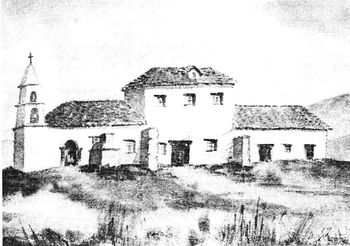Las Flores Estancia
| This article is part of a series on the Spanish missions in California  Las Flores Estancia's "San Pedro Chapel," circa 1850.[1][2] | |
| HISTORY | |
|---|---|
| Location: | San Clemente, California |
| Coordinates: | 33° 17′ 44″ N, 117° 27′ 53″ W |
| Name as Founded: | Estancia de la Misión de San Luis, Rey de Francia [3] |
| English Translation: | Station of the Mission San Luis Rey de Francia |
| Patron Saint: | Saint Peter, the Apostle [3] |
| Founding Date: | 1823 |
| Founded By: | Father Antonio Peyrí |
| Military District: | First [4][5] |
| Native Tribe(s): Spanish Name(s): |
Payomkawichum Luiseño [6] |
| Primordial Place Name(s): | Huisne [3] |
| DISPOSITION | |
| Caretaker: | United States Government |
| Current Use: | Boy Scout Camp |
| National Historic Landmark: | #NPS – 68000021 |
| Date added to the NRHP: | November 24, 1968 [7] |
| California Historical Landmark: | #616 |
The Las Flores Estancia (also known as the Las Flores Asistencia) was established by Spanish colonists on the west coast of North America in the present-day State of California (U.S. state). Founded in 1823, the way station was situated approximately halfway between Mission San Luis Rey de Francia and Mission San Juan Capistrano, on what is today Marine Corps Air Station Camp Pendleton. Designated as a historic landmark at both the state and national levels, the first recorded baptisms in Alta California took place on July 22, 1769 on the banks of a nearby stream, dubbed Los Cristianos by the Spanish soldiers who accompanied the missionaries northward during the "Portolà Expedition." [8]
History
Known at one time as the "San Pedro Rancho," the property featured a tile-roofed chapel (visita) and a hostel (both built by the native population), the latter for the use of traveling clergy. The buildings formed three sides of a square, 142 feet by 153 feet, all roofed with tile. A portion of the south wing had a second story, and the campanile ("bell tower") was utilized as a navigational aid by early sailing ships. The chapel was visited by residents of two nearby Indian villages, Chumella and Questmille. Mission San Luis Rey was raising sheep at Las Flores as early as 1810.[9] To sustain the installation barley, maize, and wheat, were grown and cattle were grazed at nearby Las Pulgas ("the fleas"); also notable was the production of hides and tallow.[10]
Although Governor José Figueroa (who took office in 1833) initially attempted to keep the mission system intact, the Mexican Congress nevertheless passed An Act for the Secularization of the Missions of California on August 17, 1833.[11] Thereafter, the Franciscans all but abandoned the Mission, taking with them most everything of value, after which the locals plundered many of the Mission buildings for construction materials. In spite of this neglect, the Indian town at Las Flores (along with those at San Juan Capistrano and San Dieguito) continued on for some time under a provision in Gobernador Echeandía's 1826 Proclamation that allowed for the partial conversion of missions to pueblos.[12]
The former estancia, located in San Diego County some 10 miles south of the City of San Clemente and later known as "Rancho Santa Margarita y Las Flores," the site was also the scene of the April, 1838 battle between the forces of Juan Bautista Alvarado and Carlos Antonio Carrillo in which the provincial governorship of Alta California was contested. Early California pioneer Marco Forster built the "Las Flores Adobe" (National Historic Landmark #NPS–68000021) in 1865 near the "San Pedro Estancia."
In 1974, the Boy Scouts of America constructed a camp ("Rancho Las Flores") on the property which is visited by thousands of scouts and other youth annually.
Notes and references
- ↑ (PD) Drawing: J.M. Carillo
- ↑ Engelhardt 1921, p. 36
- ↑ Jump up to: 3.0 3.1 3.2 Ruscin, p. 159
- ↑ Forbes, p. 202
- ↑ Engelhardt 1920, pp. v, 228: "The military district of San Diego embraced the Missions of San Diego, San Luis Rey, San Juan Capistrano, and San Gabriel..."
- ↑ Swanton, pps. 488-90, 498-99
- ↑ NHL Summary
- ↑ Leffingwell, p. 25. Today, the site (referred to more commonly as La Cañada de los Bautismos, literally "The Gorge of the Baptisms," or simply Los Christianitos, "The Little Christians") located at 33° 25′ 41.58″ N, 117° 36′ 34.92″ W is designated as California Historical Landmark #562.
- ↑ Engelhardt 1921, p. 22
- ↑ Engelhardt 1922, p. 258
- ↑ Yenne, p. 19
- ↑ Robinson, p. 42